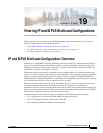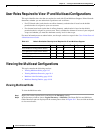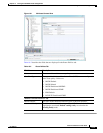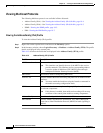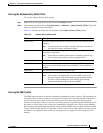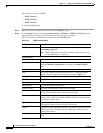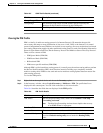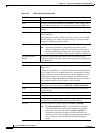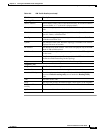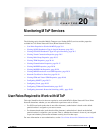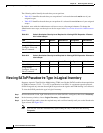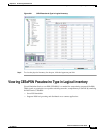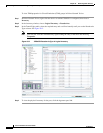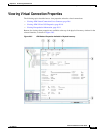
19-8
Cisco Prime Network 4.0 User Guide
OL-29343-01
Chapter 19 Viewing IP and MPLS Multicast Configurations
Viewing the Multicast Configurations
IP Address The IP address of the interface.
VRF The name of the VRF associated to the interface. This is a link, which
when clicked will take you to the relevant record under the VRF node.
PIM Status Indicates whether the PIM is enabled (ON) or disabled (OFF) on the
interface.
Hello Interval The frequency at which PIM hello messages are sent over the PIM
enabled interfaces.
These messages are sent at regular intervals by routers on all the PIM
enabled interfaces. The router sends these messages to advertise their
existence as a PIM router on the subnet.
Designated Router The IP address of the designated router on the LAN.
Note Serial lines do not have a designated router. Hence, the IP
address is displayed as 0.0.0.0. If the interface on the router is
the designated router, then the words “This system” is displayed.
If not, then the IP address of the external neighbor is displayed.
Designated Router
Priority
The priority of the designated router, which is advertised by the
neighbor in the hello messages. This value in this field will range from
0 to 4294967295
Rendezvous Points Tab
RP Address The address of the interface serving as a rendezvous point for the group
range or list.
A Rendezvous Point (RP) is a router in a multicast network domain that
acts as a shared root for a multicast shared tree. Any number of routers
can be configured to work as RPs and they can be configured to cover
different group ranges. For correct operation, every multicast router
within a Protocol Independent Multicast (PIM) domain must be able to
map a particular multicast group address to the same RP.
Mode The PIM protocol mode for which the router is advertised as a
rendezvous point. The mode can be PIM-SM or bidirectional PIM.
Scope The number of candidate announcement messages sent out from the
rendezvous point.
Priority The value of the candidate rendezvous point priority.
Uptime The amount of time from when the rendezvous point is available.
Group List The IP access list number or name of the group prefixes that are
advertised in association with the rendezvous point address.
RP Type The type of rendezvous point, which can be BSR or Auto RP.
Note The Bootstrap Router (BSR) is a mechanism for a router to
learn RP information. It ensures that all routers in the PIM
domain have the same RP cache as the BSR. Auto-RP is a
mechanism to automate distribution of RP information in a
multicast network. The Auto-RP mechanism operates using two
basic components, the candidate RPs and the RP mapping
agents.
Table 19-6 PIM Profile Details (continued)
Field Name Description




